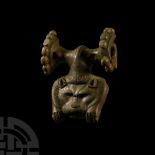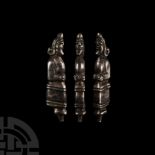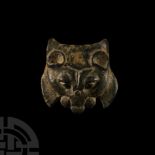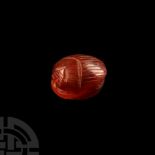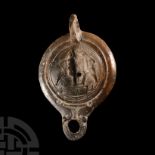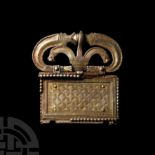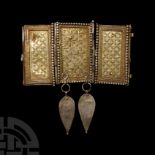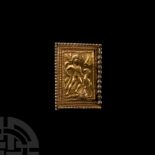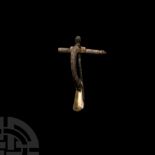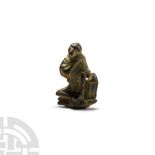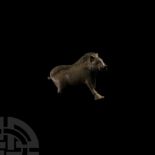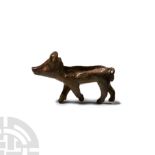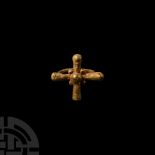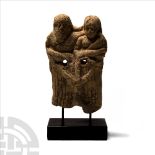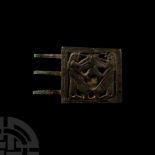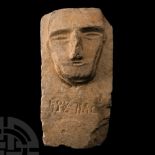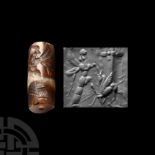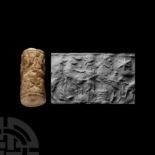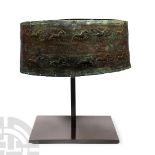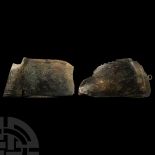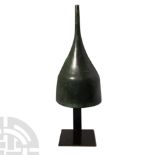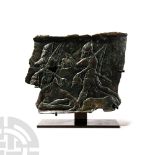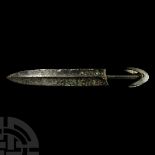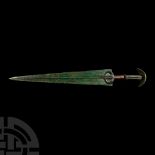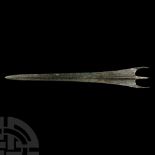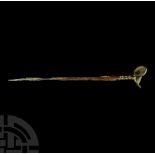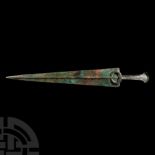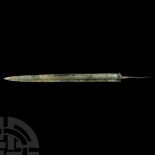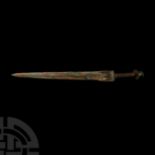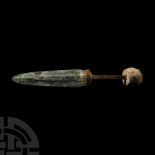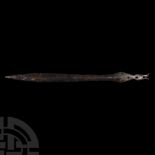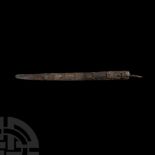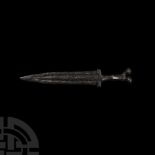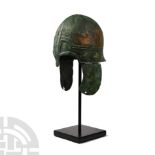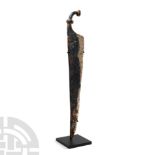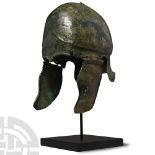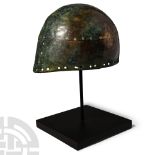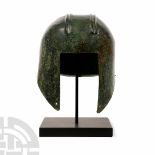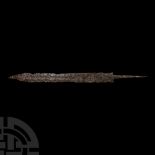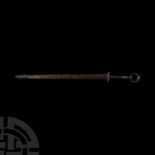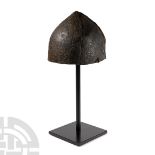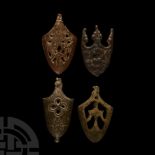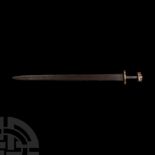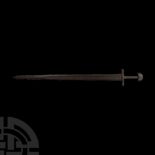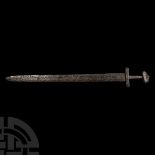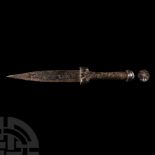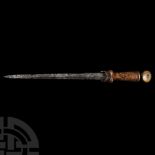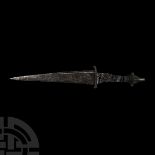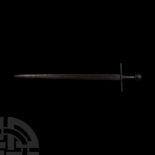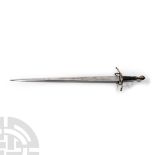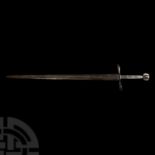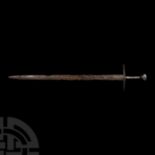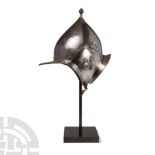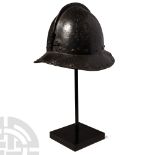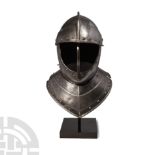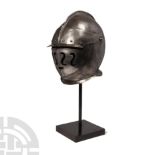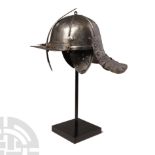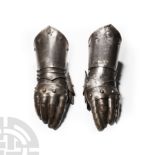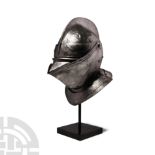Refine your search
Filtered by:
- Category,
- Item Type
- List
- Grid
A subscription to the Price Guide is required to view results for auctions ten days or older. Click here for more information
Circa 5th-4th century B.C. Formed as the skinned head and forepaws of a lion, together with two lateral handles with fastening holes surmounted by...
3rd-1st century B.C. Formed as a standing male figure with swept back, shoulder-length hair, hands held at the waist; mounting lug below. 66 grams...
Circa 5th-4th century B.C. Modelled as a skinned lion's head with fierce facial detailing; made for soldering to an articulated round handle. Cf. ...
Circa 6th-4th century B.C. Polished and incised with semi-naturalistic anatomical detailing; intaglio to base displaying archer's bow and quiver; ...
1st-2nd century A.D. Composed of a discoid body with sunken discus bearing a scene of two gladiators in combat in relief, tabula ansata below, rin...
4th-5th century A.D. Comprising a rectangular plate, richly decorated with embossed laurel leaves in a grid, framed with raised bosses, the buckle...
4th-5th century A.D. Comprising three rectangular belt fittings: two with similar laurel leaf decoration and raised border, the third central plaq...
4th century A.D. Comprising a repoussé panel with the nude hero wearing a mantle and killing the beast, a palm of victory underneath his feet, a d...
4th century A.D. Featuring rounded knops to the head, the bow with a dedicatory inscription in Latin letters 'VTER FELIX IURE VICTO'. Cf. Shelton,...
Roman Bronze Military Monkey
4th century A.D. Modelled seated on a polygonal base wearing a paenula, the right hand placed on the left shoulder, head tilted to one side, right...
Iron Age Celtic Bronze Boar
1st century B.C.-1st century A.D. Modelled in the round with semi-naturalistic detailing; void to stomach. 74 grams, 72 mm (2 7/8 in.). ‘The Ancie...
Romano-British Celtic Bronze Pig
1st century B.C.-2nd century A.D. Modelled in the round with semi-naturalistic detailing, curly tail, coat detailing; recess to back. 54 grams, 60...
Byzantine Gold Ring with Cross
Circa 6th-8th century A.D. Composed of a slender rectangular-section hoop and cruciform bezel with expanding round-section arms, central dome and ...
Old Babylonian Terracotta Couple
Circa 2000 B.C. Modelled in the half-round as a mature male figure with full beard, his left arm around the shoulder of the female figure next to ...
9th-7th century B.C. Comprising two halves decorated in chased low relief, each half with a standing winged figure dressed in long embroidered tun...
3rd-1st century B.C. Bearing a stylised male face carved in relief above a Himyarite inscription. Cf. The British Museum, museum numbers 125108; 1...
Circa 10th century B.C. Displaying a winged god standing left battling a winged quadruped, a large winged insect in the field above; drilled verti...
Sumerian Limestone Cylinder Seal
3rd millennium B.C. Depicting a figure wearing a radiate crown grappling with animals, six-armed star in the field; drilled vertically for suspens...
8th-7th century B.C. Displaying two repoussé registers of animals including lions, antelope and birds processing right between geometric borders, ...
9th-7th century B.C. Comprising two belt sections, each perforated around the edges for attachment: one with a repoussé display of alternating lio...
8th century B.C. With lateral seams, attachment holes to lower edge, bowl with tall conical peak; mounted on a custom-made stand. Cf. Born, H., Se...
Assyrian Bronze Relief Fragment
Circa 9th century B.C. Displaying a corrugated rim above and below; two advancing soldiers, each striding forwards over the headless body of a dea...
Amarlu Type Bronze Short Sword
Late 2nd millennium B.C. Composed of a massive triangular blade with a slightly raised mid-rib flanked by three parallel rows on each side, the gu...
14th-10th century B.C. Formed with a slender triangular blade, raised midrib with flat upper face, penannular guard and scooped shoulders, columna...
North-Western Bronze Short Sword
2nd-1st millennium B.C. Featuring a prominently curved guard extending out from the ricasso of the blade and partly framing the hilt, thick midrib...
10th-9th century B.C. Comprising a long tapering blade, rectangular-section hilt with raised circular bosses, horned crescent-shaped guard curved ...
Luristan Bronze Hilted Dirk
Circa 1000 B.C. The blade with a tapering profile, triangular in overall form, with square shoulders, penannular guard with strong midrib, flanged...
Late 2nd millenium B.C. Formed with a long triangular blade, thick midrib with parallel fullers, rectangular guard, long tang with folded end. See...
Luristan Bronze Sword with Hilt
13th-6th century B.C. Composed of a double-edged triangular blade with lentoid cross-section, long lower guard with strip extensions to both faces...
3rd millenium B.C. Comprising a leaf-shaped blade with broad midrib to both faces, square-section tang and pommel with discoid bronze top displayi...
10th-9th century B.C. Of Naue II Type, with broad flattened midrib to both faces of the iron blade, the blade gently broadening below the tip, ser...
1st century B.C. Accompanied by a scabbard with fragments of the slider; the sword with lentoid-section two-edged iron blade, tapering gently to a...
Iron Age Celtiberian Dagger
Circa 6th-5th century B.C. or later. Featuring a leaf-shaped double-edged iron blade, shallow fullers tapering to a point, short straight quillons...
4th-1st century B.C. Large rounded two-part bowl rivetted beneath the repoussé crest extending across the brow and around the circumference; repou...
Iron Age Celtic La Tene Dagger
1st century B.C.-1st century A.D. Featuring a gently curved single-edged iron blade and one-sided fuller, curved handle with knot pommel; mounted ...
Greek Bronze Chalcidian Helmet
5th-4th century B.C. Of Kunze Group VII, formed from two curved segments, each with a flared rim, nasal, raised panels to the upper section of the...
Late 7th-early 6th century B.C. Consisting of two sections joined with bronze rivets; above a domed section with row of rivets; below, a folded ba...
Greek Bronze Illyrian Helmet
6th-4th century B.C. Of domed Illyrian typology IIIA, variant 3, raised from a single sheet with protective cheek-pieces, two parallel corrugated ...
Roman Iron Gladius
1st-2nd century A.D. Or semi-spatha blade with parallel-sided lentoid-section body and a long rectangular-section tang; Mainz type, Wederath-Cante...
Circa 2nd-3rd century A.D. Featuring a distinctively shaped ring at the end of the grip, double-edged relatively short blade and a tapered tip. Cf...
45 B.C. Bearing a monogram: a combination of the letters 'C', 'A' and 'E', for 'C A E S' referring to Julius Caesar. Cf. D'Amato, R. and Sumner, G...
Circa 8th-12th century A.D. Comprising four triangular plates each with curved profile mounted with the frontal and rear plates overlapping the la...
9th-11th century A.D. Comprising: one heater-shaped with openwork raven motif to each face; one similar with openwork raven enmeshed in tendrils; ...
8th-10th century A.D. Comprising a double-edged tapering blade showing shallow fullers and wide cutting edges; boat-shaped lower guard with inlaid...
10th-11th century A.D. Comprising a fine double-edged tapering blade, shallow fullers and defined cutting edges showing traces of employment; shor...
10th-11th century A.D. Of Petersen Type S variant with a double-edged blade, shallow fullers and a rounded point; boat-shaped upper and lower guar...
Late 15th-early 16th century A.D. Comprising a single-edged blade, whittle tang and cylindrical grip terminating in a bulbous openwork pommel. Cf....
Medieval Iron Kidney Dagger
Late 15th century A.D. Featuring a wedge-shaped blade and a lobed handle; the hilt fitted with an iron plate bending down to form points on each s...
England or Germany, 16th century A.D. Featuring a hexagonal brass pommel engraved with a fleur-de-lis to one side and a dragon to the other; pierc...
Late 13th-early 14th century A.D. Of Oakeshott Type XII or XIII with a double-edged, well-balanced tapering blade, shallow fullers and a parallel-...
15th century A.D. Comprising a straight, flat triple fuller, double edged and tapering blade engraved with imperial orb sign, Passau wolf mark dat...
14th-15th century A.D. Comprising a broad, double-edged blade with rounded tip, shallow central fuller to the upper third of both sides; flat guar...
Circa 14th-15th century A.D. Of Oakeshott type XVIIIa or b with a strongly tapering blade of flattened diamond-section without fullers; the lower ...
South German Burgonet Helm
Circa 1560-1570 A.D. The one-piece skull rising to a prominent baluster-shaped finial, facetted upper half, the lower writhen projecting forward t...
Cromwellian Pikeman's Pot Helmet
1642-1651 A.D. Of Morion Cabasset Type, the iron bowl composed of two rivetted parts with a crest; plume holder to the rear; wide sloping brim wit...
Circa 1620 A.D. Iron fronted with visor, nasal guard bar and front and back gorget plates, the lifting visor marked with parallel lines; the front...
European Savoyard Burgonet
Circa 1620 A.D. Comprising a full face shield with broad wavy bars and a small mouth opening, a wide hinged visor; the visor and the front section...
English Civil War Helmet
Mid 17th century A.D. Of Dutch lobster-tailed pot type, the neck-guard composed of four articulated sections; wide brim with a movable nasal-guard...
Circa 1600 A.D. Each with nail detailing to the thumb and sprays of dashes decorating the edges, ridges and rivets of certain plates; leather lini...
German Closed Iron Helm
Circa 1560 A.D. An armet with rounded one-piece skull raising to a roped medial comb, visor, prow shaped upper bevor and bevor attached by common ...

